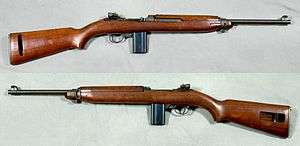M1 carbine
| Carbine, Caliber .30, M1 | |
|---|---|
|
M1 Carbine | |
| Type |
|
| Place of origin | United States |
| Service history | |
| In service | July 1942–1973 (United States) |
| Used by | See Users |
| Wars |
World War II Hukbalahap Rebellion Malayan Emergency Suez Crisis Korean War Cuban Revolution First Indochina War Vietnam War The Troubles Cambodian Civil War Angolan Civil War Mexican Drug War |
| Production history | |
| Designer |
Frederick L. Humeston William C. Roemer David Marshall Williams |
| Designed | 1938–41 |
| Manufacturer |
Military contractors Commercial copies |
| Unit cost | $45 (WW2) |
| Produced | September 1941–August 1945; commercial 1945–present |
| Number built | Over 6.5 million |
| Variants | M1A1, M1A3, M2, M2A2, M3 |
| Specifications | |
| Weight |
5.2 lb (2.4 kg) empty 5.8 lb (2.6 kg) loaded w/ sling |
| Length | 35.6 in (900 mm) |
| Barrel length | 18 in (460 mm) |
|
| |
| Cartridge | .30 Carbine |
| Action | Gas-operated (short-stroke piston), rotating bolt |
| Rate of fire |
Semi-automatic (M1/A1) 750 rounds/min (M2)[1] |
| Muzzle velocity | 1,990 ft/s (607 m/s) |
| Effective firing range | 300 yd (270 m) |
| Feed system | 15- or 30-round detachable box magazine |
| Sights | Rear sight: aperture; L-type flip or adjustable, front sight: wing-protected post |
The M1 carbine (formally the United States Carbine, Caliber .30, M1) is a lightweight, easy to use,[2] .30 caliber semi-automatic carbine that was a standard firearm for the U.S. military during World War II, the Korean War and well into the Vietnam War. The M1 carbine was produced in several variants and was widely used by not only the U.S. military, but by military, paramilitary and police forces around the world. It has also been a popular civilian firearm.
The M2 carbine is the selective-fire version of the M1 carbine capable of firing in both semi-automatic and full-automatic. The M3 carbine was an M2 carbine with an active infrared scope system.[3]
Despite its name and similar appearance, the M1 carbine is not a shorter version of the M1 Garand rifle. It is a completely different firearm and it fires a different type of ammunition. It was simply called a carbine because it is smaller and lighter than the Garand.
On July 1, 1925, the U.S. Army began using the current naming system where the "M" is the designation for Model and the "number" represents the sequential development of equipment and weapons.[4] Therefore, the "M1 rifle" was the first rifle developed under this system. The "M1 carbine" was the first carbine developed under this system. The "M2 carbine" was the second carbine developed under the system, etc.
Development history
Limitations of weapons in the U.S. arsenal
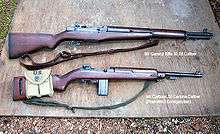


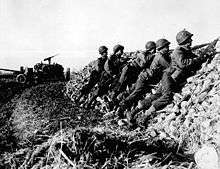
Prior to World War II, U.S. Army Ordnance received reports that the full-size M1 rifle was too heavy and cumbersome for most support troops (staff, mortarmen, radiomen, etc.) to carry. During prewar and early war field exercises, it was found that the M1 Garand impeded these soldier's mobility, as a slung rifle would frequently catch on brush, bang the helmet, or tilt it over the eyes. Many soldiers found the rifle slid off the shoulder unless slung diagonally across the back, where it prevented the wearing of standard field packs and haversacks.
Additionally, Germany's use of glider-borne and paratroop forces to launch surprise attacks behind the front lines, generated a request for a new compact infantry weapon to equip support troops.[5][6] This request called for a compact, lightweight defensive weapon with greater range, accuracy and firepower than handguns, while weighing half as much as the Thompson submachine gun or the M1 rifle.[5] The U.S. Army decided that a carbine would adequately fulfill all of these requirements, but specified that the new arm should weigh no more than five pounds and have an effective range of 300 yards.[7][8] Paratroopers were also added to the list of intended users and a folding-stock version would also be developed.
Designing the M1 carbine
In 1938, the Chief of Infantry requested that the Ordnance Department develop a "light rifle" or carbine, though the formal requirement for the weapon type was not approved until 1940. This led to a competition in 1941 by major U.S. firearm companies and designers.
Winchester at first did not submit a carbine design, as it was occupied in developing the .30-06 Winchester M2 Military Rifle. The rifle originated as a design by Jonathan "Ed" Browning, brother of the famous firearm designer John Browning. A couple of months after Ed Browning's death in May 1939, Winchester hired David Marshall "Carbine" Williams who had begun work on a short-stroke gas piston design while serving a prison sentence at a North Carolina minimum-security work farm. Winchester, after Williams' release, had hired Williams on the strength of recommendations of firearms industry leaders, and hoped Williams would be able to complete various designs left unfinished by Ed Browning, including the Winchester .30-06 M2 rifle. Williams incorporated his short-stroke piston in the existing design. After the Marine Corps semi-automatic rifle trials in 1940, Browning's rear-locking tilting bolt design proved unreliable in sandy conditions. As a result, the rifle was redesigned to incorporate a Garand-style rotating bolt and operating rod, retaining Williams' short-stroke piston. By May 1941, Williams had shaved the M2 rifle prototype from about 9.5 lb (4.3 kg) to a mere 7.5 lb (3.4 kg).
Ordnance found unsatisfactory the first series of prototype carbines submitted by several firearms companies and some independent designers.[9] Winchester had contacted the Ordnance Corps to examine their rifle M2 design. Major René Studler of Ordnance believed the rifle design could be scaled down to a carbine which would weigh 4.5 to 4.75 lb (2.0–2.2 kg) and demanded a prototype as soon as possible. The first model was developed at Winchester in 13 days by William C. Roemer, Fred Humeston and three other Winchester engineers under supervision of Edwin Pugsley, and was essentially Williams' last version of the .30-06 M2 scaled down to the .30 SL cartridge.[10] This patchwork prototype was cobbled together using the trigger housing and lockwork of a Winchester M1905 rifle and a modified Garand operating rod. The prototype was an immediate hit with army observers.[11]
After the initial army testing in August 1941, the Winchester design team set out to develop a more refined version. Williams participated in the finishing of this prototype. The second prototype competed successfully against all remaining carbine candidates in September 1941, and Winchester was notified of their success the very next month. Standardization as the M1 Carbine was approved on October 22, 1941. This story was the loose basis for the 1952 movie Carbine Williams starring James Stewart. Contrary to the movie, Williams had little to do with the carbine's development, with the exception of his short-stroke gas piston design. Williams worked on his own design apart from the other Winchester staff, but it was not ready for testing until December 1941, two months after the Winchester M1 Carbine had been adopted and type-classified. Winchester supervisor Edwin Pugsley conceded that Williams' final design was "an advance on the one that was accepted", but noted that Williams' decision to go it alone was a distinct impediment to the project,[10] and Williams' additional design features were not incorporated into M1 production. In a 1951 memo written in fear of a patent infringement lawsuit by Williams, Winchester noted his patent for the short-stroke piston may have been improperly granted as a previous patent covering the same principle of operation was overlooked by the patent office.[10]
In 1973 the senior technical editor at the NRA contacted Edwin Pugsley for "a technical last testament" on M1 carbine history shortly before his death 19 Nov 1975. According to Pugsley, "The carbine was invented by no single man," but was the result of a team effort including Bill Roemer, Marsh Williams, Fred Humeston, Cliff Warner, at least three other Winchester engineers, and Pugsley himself. Ideas were taken and modified from the Winchester M2 Browning rifle (Williams' gas system), the Winchester 1905 rifle (fire control group), M1 Garand (buttstock dimensions and bolt and operating slide principles), and a percussion shotgun in Pugsley's collection (hook breech and barrel band assembly/disassembly).[12]
Features

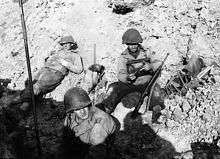

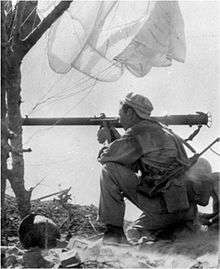

Ammunition
The .30 Carbine cartridge is essentially a rimless version of the then obsolete .32 Winchester Self-Loading cartridge introduced for the Winchester Model 1905 rifle.[13] The propellant was much newer, though, taking advantage of chemistry advances. As a result, the .30 Carbine is approximately 27% more powerful than its parent cartridge. A standard .30 Carbine ball bullet weighs 110 grains (7.1 g), a complete loaded round weighs 195 grains (12.6 g) and has a muzzle velocity of 1,990 ft/s (610 m/s) giving it 967 ft·lbf (1,311 joules) of energy, when fired from the M1 carbine's 18" barrel.
At 100 yards (91 m), the M1 carbine can deliver groups between 3 and 5 inches, sufficient for its intended purpose as a close-range defensive weapon. The M1 carbine has a maximum range of 300 yards (270 m). However, bullet drop is significant past 200 yards (180 m).[13] Therefore, the M1 has practical effective range of about 200 yards.[14]
By comparison, The .30-06 M1 Garand is almost 3 times more powerful than the Carbine. M1 Garand rifles fire a .30 caliber ball bullet weighing 152 grains (9.8 g) at a muzzle velocity of 2,805 ft/s (855 m/s) giving a muzzle energy of 2,655 ft/lb (3,600 joules). However, the M1 carbine's ballistics are markedly superior to the .45ACP caliber submachine guns in common use at the time. As a result, the carbine offers much better range, accuracy and penetration.[5] The M1 is also half the weight of a Thompson submachine gun and fires a lighter cartridge. Therefore, soldiers armed with the Carbine can carry much more ammunition than those armed with a Tommy Gun.
Categorizing the M1 carbine series has been the subject of much debate. Although commonly compared to the later German StG44 and Russian AK-47, the M1 and M2 carbines are under-powered and outclassed by comparison.[15] The Carbine instead falls somewhere between the submachine gun and the assault rifle, and could be called a Personal Defense Weapon since it fulfilled a similar role.
One characteristic of .30 Carbine ammunition is that from the beginning of production, non-corrosive primers were specified. This was the first major use of this type of primer in a military firearm. Because the rifle had a closed gas system, not normally disassembled, corrosive primers would have led to a rapid deterioration of the gas system.[16] The use of non-corrosive primers was a novelty in service ammunition at this time.[17] Some failures to fire were reported in early lots of .30 Carbine ammunition, attributed to moisture ingress of the non-corrosive primer compound.[18]
Sights
The M1 carbine entered service with a simple flip sight, which had two settings: 150 and 300 yards.[19] However, field reports indicated that this sight was inadequate, and in 1944, it was replaced by a sliding ramp-type adjustable sight with four settings: 100, 200, 250 and 300 yards.[20] This new rear sight was also adjustable for windage.
Magazines
The M1 carbine entered service with a standard straight 15-round box magazine. The introduction of the select-fire M2 carbine in October 1944[21] also brought into service the curved 30-round magazine or "Banana Clip".[22] After WW2, the 30-round magazine quickly became the standard magazine for both the M1 and M2 carbines, although the 15-round magazine remained in service until the end of the Vietnam war.[23]
Perhaps the most common accessory used on the M1 carbine was a standard magazine belt pouch that was mounted to the right side of the stock and held two extra 15-round magazines. After the introduction of the 30-round magazine, it was common for troops to tape two 30-round magazines together. This led the military to introduce the "Holder, Magazine T3-A1" also called the "Jungle Clip", a metal clamp that held two magazines together without the need for tape.
The 30-round magazines introduced for use with the selective-fire M2 Carbine would not be reliably retained by the magazine catch made for the original M1 Carbine which was designed to retain a 15-round magazine, so the much heavier (when loaded) 30-round magazine would not be properly seated in the M1 Carbine magazine well. The loaded 30-round magazine would typically cant (impairing feed reliability) or even fall out, which helps explain why the 30-round magazines have a poor reliability record (they are also more prone to damage due to their added length and weight when loaded as thin steel is used to make them). Thus early production M1 Carbines must be fitted with the type IV magazine catch used on the M2 Carbine (and late production M1 Carbines) if it is to be used with 30-round magazines. The type IV magazine catch will have a leg on the left side to correspond with the additional nub on the 30-round magazines.[24] It is also desirable to load 30-round magazines with only 25 rounds to protect their springs from metal fatigue, which can occur if they are left fully loaded for long periods.
Also, in the heat of combat, the M1 carbine's magazine release button was often mistaken for the safety.[20] This caused soldiers to accidentally release the magazine when they meant to disengage the safety. As a result, the push-button safety was redesigned into a rotating lever-type safety.[20][25]
Accessories
Due to requests from the field, the carbine was modified to incorporate a bayonet lug starting in 1945.[26] However, very few carbines with bayonet lugs reached the front lines before the end of World War II. By the start of the Korean War, the bayonet lug-equipped M1 was standard issue. It is now rare to find an original M1 carbine without the bayonet lug. The M1 carbine mounts the standard M4 bayonet, which was based on the earlier M3 fighting knife and formed the basis for the later M5, M6 and M7 bayonet-knives.
A folding-stock version of the carbine (the M1A1) was also developed after a request for a compact and light infantry arm for airborne troops. The Inland Division of General Motors manufactured 140,000 of them in two product runs in late 1942.[21] They were originally issued to the 82nd and 101st Airborne divisions but were later issued to all army airborne units and the US Marine Corps.[21]
As carbines were reconditioned, parts such as the magazine catch, rear sight, barrel band without bayonet lug, and stock were upgraded with current standard-issue parts. Also, both during and after WW2, many semi-automatic M1 carbines were converted to select-fire M2 carbines by using the T17 and T18 conversion kits.[27] The conversion included a modified sear and slide and added a disconnector, disconnector lever, and selector switch that could be set for semi-auto or full-automatic fire.
During World War II, the T23 (M3) flash hider was designed to reduce the muzzle flash from the carbine, but was not introduced into service until the advent of the M3 carbine.[28] With the exception of T23 hiders mounted on M3 carbines, few if any T23 flash-hider attachments saw service during the war, though unit armorers occasionally hand-built improvised compensator/flash-hiders of their own design.[28][29]
The M1 carbine was used with the M8 grenade launcher, which was developed in early 1944. It was fired with the .30 Carbine M6 Grenade Blank cartridge to launch 22 mm rifle grenades. Stress from firing rifle grenades would eventually crack the carbine's stock. It also could not use the M8 launcher with an M7 auxiliary "booster" charge (to extend its range) without breaking the stock. This made it a type of emergency-issue weapon.
Production

A total of over 6.5 million M1 carbines of various models were manufactured, making it the most produced small arm for the American military during World War II (compared with about 6 million M1 rifles and under 2 million Thompson submachine guns). Despite being designed by Winchester, the great majority of these were made by other companies (see list of Military contractors below). The largest producer was the Inland division of General Motors, but many others were made by contractors as diverse as IBM, the Underwood typewriter company, and the Rock-Ola jukebox company. Few contractors made all the parts for carbines bearing their names: some makers bought parts from other major contractors or sub-contracted minor parts to companies like Marlin Firearms or Auto-Ordnance. Parts by all makers were required to be interchangeable. Often one company would get ahead or behind in production and parts would be shipped from one company to the other to help them catch up on their quota. When receivers were shipped for this purpose the manufacturers would often mark them for both companies. One of the stranger combinations were the M1's made by the combined efforts of Underwood and Quality Hardware. One has to wonder what the GI thought when he looked at the manufacture's name of the Carbine he had been issued to carry into battle when it was marked UN-QUALITY.[30] Many carbines were refurbished at several arsenals after the war, with many parts interchanged from original maker carbines. True untouched war production carbines, therefore, are the most desirable for collectors.[31]
The M1 carbine was also one of the most cost effective weapons used by the United States Military during World War II. At the beginning of World War II the average production cost for an M1 carbine was approximately $45, about half the cost of an M1 rifle at approximately $85 and about a fifth of the cost of a Thompson submachine gun at approximately $225. The .30 Carbine ammunition was also far cheaper to produce than the standard .30-06 ammunition; used less resources, was smaller, lighter, faster and easier to make. These were major factors in the United States Military decision to adopt the M1 carbine, especially when considering the vast numbers of weapons and ammunition manufactured and transported by the United States during World War II.
U.S. combat use
World War II
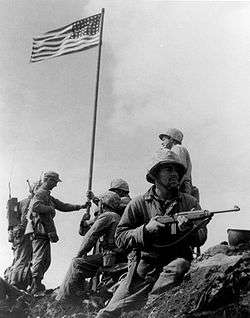
The M1 carbine with its reduced-power .30 cartridge was not originally intended to serve as a primary weapon for combat infantrymen, nor was it comparable to more powerful assault rifles developed late in the war. However, it was markedly superior to the .45-caliber submachineguns in use at the time in both accuracy and penetration,[5] and its lighter .30 cartridge allowed soldiers to carry more ammunition. As a result, the carbine was soon widely issued to infantry officers, American paratroopers,[32] NCOs, ammunition bearers, forward artillery observers, and other frontline troops.[33] The first M1 carbines were delivered in mid-1942, with initial priority given to troops in the European Theater of Operations (ETO).[5]
The M1 carbine gained generally high praise for its small size, light weight and firepower, especially by those troops who were unable to use a full-size rifle as their primary weapon.[34][35] However, its reputation in front-line combat was mixed and negative reports began to surface with airborne operations in Sicily in 1943,[36] and increased during the fall and winter of 1944.[37]
In the Pacific theater, soldiers and guerrilla forces operating in heavy jungle with only occasional enemy contact praised the carbine for its small size, light weight, and firepower.[38] Although, the Carbine bullets would easily penetrate the front and back of steel helmets, as well as the body armor used by Japanese forces of the era.[39][40] Soldiers and Marines engaged in frequent daily firefights (particularly those serving in the Philippines) found the weapon to have insufficient penetration and stopping power.[41][42] Reports of the carbine's failure to stop enemy soldiers, sometimes after multiple hits, appeared in individual after-action reports, postwar evaluations, and service histories of both the U.S. Army and the U.S. Marine Corps.[41][43]
The carbine's exclusive use of non-corrosive-primer ammunition was found to be a godsend by troops and ordnance personnel serving in the Pacific, where barrel corrosion was a significant issue with the corrosive primers used in .30-06 caliber weapons.[41] However, in the ETO some soldiers reported misfires attributed to moisture ingress of the non-corrosive primer compound.[18]
Selective-fire version
Initially, the M1 carbine was intended to have a select-fire capability, but in order to speed up development it was decided to omit this feature. On 26 October 1944, in response to the Germans widespread use of automatic weapons, especially the Sturmgewehr 44 assault rifle, the select-fire M2 carbine was adopted, along with a new 30-round magazine. The M2 had a fully automatic rate-of-fire of about 850-900 rounds-per-minute. Although actual M2 production began late in the war (April 1945), US Ordnance issued conversion-part kits to allow field conversion of semi-auto M1 carbines to the selective-fire M2 configuration. These converted M1/M2 select-fire carbines saw limited combat service in Europe, primarily during the final Allied advance into Germany. In the Pacific, both converted and original M2 carbines saw limited use in the last days of the fighting in the Philippines.[29]
Infrared sight versions
The M3 carbine was an M2 carbine with the M2 infrared night sight or sniperscope.[3] The M3 did not have iron sights.[3] It was first used in combat by Army units during the invasion of Okinawa, about 150 M3 were used on Okinawa. For the first time, U.S. soldiers had a weapon that allowed them to visually detect Japanese infiltrating into American lines at night, even during complete darkness. A team of two or three soldiers was used to operate the weapon and provide support.[44] At night, the scope would be used to detect Japanese patrols and assault units moving forward. At that point, the operator would fire a burst of automatic fire at the greenish images of enemy soldiers.[44] The M3 carbine had an effective range of about 70 yards (64 meters), limited by the visual capabilities of the sight.[45] Fog and rain further reduced the weapon's effective range.[44][45] However, it is estimated that fully 30% of Japanese casualties inflicted by rifle and carbine fire during the Okinawan campaign were caused by the M3 carbine.[44]
The system was refined over time, and by the Korean War the improved M3 infrared night sight was in service. The M3 sight has a longer effective range than its predecessor, about 125 yards (114 meters). However, it still required the user to carry a heavy backpack-mounted battery pack to power the scope and infrared light. They were used primarily in static defensive positions in Korea to locate troops attempting to infiltrate in darkness. In total, about 20,000 sets were made before they became obsolete, and were surplussed to the public.
Korean War
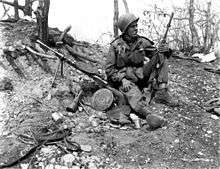
By the Korean War, the select fire M2 carbine had largely replaced the submachine-gun in U.S. service[46] and was the most widely used Carbine variant.[47][48] Although, the semi-auto M1 carbine was also widely use, especially by support troops. However, in Korea, all versions of the carbine soon acquired a widespread reputation for jamming in extreme cold weather,[49][50][51] this being eventually traced to weak return springs and poor maintenance under the harsh conditions.[52][53]
There were also many complaints from individual soldiers that the carbine bullet failed to stop heavily clothed[54][55][56][57] or gear-laden[58][59][60] North Korean and Chinese (PVA) troops even at close range and after multiple hits.[50][52][61] Marines of the 1st Marine Division also reported instances of carbine bullets failing to stop enemy soldiers, and some units issued standing orders for carbine users to aim for the head.[62][63] PVA infantry forces who had been issued captured U.S. small arms disliked the carbine for the same reason.[64]
A 1951 official U.S. Army evaluation reported that..."There are practically no data bearing on the accuracy of the carbine at ranges in excess of 50 yards. The record contains a few examples of carbine-aimed fire felling an enemy soldier at this distance or perhaps a little more. But they are so few in number that no general conclusion can be drawn from them. Where carbine fire had proved killing effect, approximately 95 percent of the time the target was dropped at less than 50 yards."[65] The evaluation also reported that..."Commanders noted that it took two to three engagements at least to settle their men to the automatic feature of the carbine so that they would not greatly waste ammunition under the first impulse of engagement. By experience, they would come to handle it semiautomatically, but it took prolonged battle hardening to bring about this adjustment in the human equation."[65]
Despite its mixed reputation, the M2 carbine's firepower often made it the weapon of choice, when it came to night patrols in Korea.[65][66] And, troops would tape two or three 30 round magazines together to speed up the process of reloading.[66] The M3 carbine with its infrared sniperscope was also used against night infiltrators, especially during the static stages of the conflict. M3 operators would not only use their carbines to dispatch individual targets, but also used tracer ammo to identify troop concentrations for machine gunners to decimate.[66]
Vietnam War
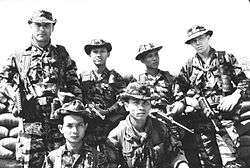
The M1 and M2 carbines were again issued to U.S. forces during the Vietnam War, particularly with United States Air Force Security Police and United States Army Special Forces. These weapons began to be replaced by the M16 and by 1964 they were generally out of service by the mid 1970s, although they were used in limited numbers by U.S. troops and security personnel until the fall of Saigon in 1975.
At least 793,994 M1 and M2 carbines were given to the South Vietnamese and were widely used throughout the Vietnam War.[67] A number were captured during the war by Vietcong.[68] "While the carbine's lighter weight and high rate of fire made it an excellent weapon for small-statured Asians, these guns lacked sufficient hitting power and penetration, and they were eventually outclassed by the AK-47 assault rifle."[15]
The M1/M2/M3 carbines were the most heavily produced family of U.S. military weapons for several decades. They were used by every branch of the U.S. Armed Forces.
Foreign usage

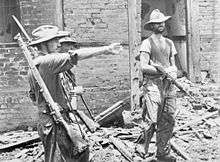
After World War II, the M1 and M2 carbines were widely exported to U.S. allies and client states (1,015,568 to South Korea, 793,994 to South Vietnam, 269,644 to France, etc.),[67] they were used as a frontline weapon well into the Vietnam War era, and they continue to be used by military, police, and security forces around the world to this day.
British Army
During World War II, the British SAS used the M1 and M1A1 carbines after 1943. The weapon was taken into use simply because a decision had been taken by Allied authorities to supply .30 caliber weapons from US stocks in the weapons containers dropped to Resistance groups sponsored by an SOE, or later also Office of Strategic Services (OSS), organizer, on the assumption the groups so supplied would be operating in areas within the operational boundaries of U.S. forces committed to Operation Overlord. They were found to be suited to the kind of operation the two British, two French, and one Belgian Regiment carried out. It was handy enough to parachute with, and, in addition, could be easily stowed in an operational Jeep. Other specialist intelligence collection units, such as 30 Assault Unit sponsored by the Naval Intelligence Division of the British Admiralty, which operated across the entire Allied area of operations, also made use of this weapon.. The Carbine continued to be utilized as late as the Malayan Emergency, by the Police Field Force[69] of the Royal Malaysian Police, along with other units of the British Army,[70][71] were issued the M2 Carbine for both jungle patrols and outpost defense. The Royal Ulster Constabulary also used the M1 carbine.[72]
German Army
Small numbers of captured M1 carbines were used by German forces in World War II, particularly after D-Day.[73] The German designation for captured carbines was Selbstladekarabiner 455(a). The "(a)" came from the country name in German; in this case, Amerika. It was also used by German police and border guards in Bavaria after World War II and into the 1950s. The carbines were stamped according to the branch they were in service with; for instance, those used by the border guard were stamped "Bundesgrenzschutz". Some of these weapons were modified with different sights, finishes, and sometimes new barrels.
Japanese Army
A variant was produced shortly after World War II by the Japanese manufacturer Howa Machinery, under U.S. supervision. These were issued to all branches of the Japan Self-Defense Forces, and large numbers of them found their way to Southeast Asia during the Vietnam War.
Israel Defense Forces
The M1 carbine was also used by the Israeli Palmach-based special forces in the 1948 Arab-Israeli War. And, because of their compact size and semi-auto capabilities, they continued to be used by Israeli Defence Forces after the creation of Israel. The Israeli police still use the M1 carbine as a standard long gun for non-combat elements and Mash'az volunteers.
French
The U.S. provided France with 269,644 M1 and M2 carbines from World War II to 1963.[74] The M1 carbine was used by the French Paratroopers and Legionnaires during the Indo-China War and Algerian War.[75] The M1 carbine was also popular in French Expeditionary Force in Vietnam because of it was ideal for use at close ranges, being better suited to jungle fighting than French standard infantry rifles. French troops discovered its ammunition was deadlier in close range combat.


South Vietnam
The U.S. provided the Army of the Republic of Vietnam with 793,994 M1 and M2 carbines from 1963 to 1973.[76] Along with tens of thousands of Carbines left behind by the French after the First Indochina War, the M1 and M2 carbines were the most widely issued small arm during the early stages in the Vietnam War and remained in service in large numbers until the fall of Saigon. The South Vietnamese would also received 220,300 M1 Garands and 520 M1C/M1D rifles,[77] and 640,000 M-16 rifles.
The Viet Cong also use large numbers of M1 and M2 Carbines, captured from the French, ARVN and local militia forces of South Vietnam. As well as, receiving many thousands of Carbines from North Vietnamese Army (NVA), China and North Korea. Over time, the SKS and eventually the AK-47 would replace the Carbine to become the dominant weapons used by the by Viet Cong.nt
South Korea
The Republic of Korea Armed Forces received 1,015,568 M1 and M2 carbines from 1963 to 1972.[67] Along with hundred thousands of Carbines and M1 Garands provided by the United States Army before, during and shortly after the Korean war, South Korea would become the largest single recipient of American M1 and M2 carbines.
The Republic of Korea also took an active role in the Vietnam War. From 1964 to 1973, South Korea sent more than 300,000 troops to Vietnam armed primarily with M1 and M2 carbines, as well as M1 Garands. The South Korean Army, Marine Corps, Navy, and Air Force all participated as an ally of the United States. The number of troops from South Korea was much greater than those from Australia and New Zealand, and second only to the U.S. military force.
Philippines
The government of the Philippines still issues M1 carbines to the infantrymen of the Philippine Army's 2nd Infantry Division assigned in Luzon Island (some units are issued just M14 Automatic Rifles and M1 Carbines) and the Civilian Auxiliary Forces Geographical Unit (CAFGU) and Civilian Volunteer Organizations (CVO)spread throughout the Philippines. Certain provincial police units of the Philippine National Police (PNP) still use government-issue M1 carbines as well as some operating units of the National Bureau of Investigation (NBI). In many provinces of the Philippines, M1 carbines are still highly valued as a light small arm. Elements of the New People's Army and Islamic Secessionist movement value the carbine as a lightweight weapon and preferred choice for mountain and ambush operations.
The M1 carbine has become one of the most recognized firearms in Philippine society, with the Marikina City-based company ARMSCOR Philippines still continuing to manufacture .30 caliber ammunition for the Philippine market.
Counter insurgency
The M1 and M2 carbines were widely used by military, police, and security forces and their opponents during the many guerrilla and civil wars throughout Latin America until the 1990s, when they were mostly replaced by more modern designs. A notable user was Che Guevara who used them during the Cuban Revolution and in Bolivia where he was executed by a Bolivian soldier armed with an M2 Carbine.[78]
In Rio de Janeiro, Brazil, a police battalion named Batalhão de Operações Policiais Especiais (BOPE, or "Special Police Operations Battalion") still uses the M1 carbine.
Users
The unit data provided below refers to original U.S. Ordnance contract carbines the United States provided these countries. Many countries sold, traded, destroyed, and/or donated these carbines to other countries and/or private gun brokers.[67]
Current users
.jpg)
 Brazil: In service with BOPE from Rio de Janeiro[79]
Brazil: In service with BOPE from Rio de Janeiro[79] Indonesia: Used by Indonesian Armed Forces in 1950s and 1960s. Still in service of Kepolisian Republik Indonesia
Indonesia: Used by Indonesian Armed Forces in 1950s and 1960s. Still in service of Kepolisian Republik Indonesia Israel: (1970s–present, Israel Police; 1974–present, Civil Guard)
Israel: (1970s–present, Israel Police; 1974–present, Civil Guard) Italy: Nunziatella military academy
Italy: Nunziatella military academy South Korea: 1,015,558 units[67](1950s-Present, Reserve Force)
South Korea: 1,015,558 units[67](1950s-Present, Reserve Force) Suriname: (?-Present, Army)
Suriname: (?-Present, Army) Taiwan: 115,948 units[67] (Republic of China) (1950s-present)
Taiwan: 115,948 units[67] (Republic of China) (1950s-present) Philippines: 8,831 units[67](Pre and Post-World War II, 1942-1970s) Reserve with Philippine navy
Philippines: 8,831 units[67](Pre and Post-World War II, 1942-1970s) Reserve with Philippine navy
Former users
 Algeria: (Captured in large numbers from French military personnel during the Algerian Independence War)[75]
Algeria: (Captured in large numbers from French military personnel during the Algerian Independence War)[75] Angola: 12,215 units[67]
Angola: 12,215 units[67]
 FNLA: (Unknown number captured/illegally acquired for use during the Angolan Civil War)[80]
FNLA: (Unknown number captured/illegally acquired for use during the Angolan Civil War)[80]
 Argentina: 12,621 units[67]
Argentina: 12,621 units[67] Austria: 39,005 units[67][81](1950s–70s, Austrian Army and Police)
Austria: 39,005 units[67][81](1950s–70s, Austrian Army and Police).svg.png) Bavaria: 14,647 units[82](1945–early 1950s, Border Guard)
Bavaria: 14,647 units[82](1945–early 1950s, Border Guard) Brazil: (1944-1945, Brazilian Expeditionary Force)
Brazil: (1944-1945, Brazilian Expeditionary Force) Bolivia: 13,438 units[67]
Bolivia: 13,438 units[67] Burma: 28,792 units[67]
Burma: 28,792 units[67] Cambodia: 115,568 units[67] (Khmer Republic)[83] (1967–1975)
Cambodia: 115,568 units[67] (Khmer Republic)[83] (1967–1975) Canada: 230 units,[67] M2 variant seen in use by Canadian law enforcement personnel responding to the 1984 Quebec National Assembly Shooting.[84]
Canada: 230 units,[67] M2 variant seen in use by Canadian law enforcement personnel responding to the 1984 Quebec National Assembly Shooting.[84] Chile: 2,877 units[67]
Chile: 2,877 units[67] China: 361 units[67]
China: 361 units[67] Colombia: 7,037 units[67]
Colombia: 7,037 units[67] Costa Rica: 6,000 units[67]
Costa Rica: 6,000 units[67] Cuba: 118 units[67]
Cuba: 118 units[67] Ecuador: 576 units[67]
Ecuador: 576 units[67] El Salvador: 156 units[67]
El Salvador: 156 units[67]

 Ethiopia: 16,417 units[67][85]
Ethiopia: 16,417 units[67][85] France: 269,644 units[67](1954–1962, Algerian War)
France: 269,644 units[67](1954–1962, Algerian War)
 French Indochina: 35,429 units[67]
French Indochina: 35,429 units[67]
.svg.png) Nazi Germany: Limited issue. Captured M1 carbines were classified as the Selbstladekarabiner 455(a) ("Self-loading carbine #455 (American)").[21] There are pictures of late-war Fallschirmjäger troops and SS Leibstandarte Adolf Hitler ("Adolf Hitler's SS Bodyguard Regiment") soldiers armed with them.[21]
Nazi Germany: Limited issue. Captured M1 carbines were classified as the Selbstladekarabiner 455(a) ("Self-loading carbine #455 (American)").[21] There are pictures of late-war Fallschirmjäger troops and SS Leibstandarte Adolf Hitler ("Adolf Hitler's SS Bodyguard Regiment") soldiers armed with them.[21] West Germany: 34,192 units[67] German Border Guard, some Police forces and German Army paratroopers (1950s-1960s)
West Germany: 34,192 units[67] German Border Guard, some Police forces and German Army paratroopers (1950s-1960s) Greece: 38,264 units[67](Hellenic (Greek) Air Force until mid-1990s)
Greece: 38,264 units[67](Hellenic (Greek) Air Force until mid-1990s) Guatemala: 6063 units[67][86]
Guatemala: 6063 units[67][86] Honduras: 5,581 units[67]
Honduras: 5,581 units[67] Iran: 10,000 units[67]
Iran: 10,000 units[67] Ireland:[87] (1969-1980s, Used by the Provisional IRA , Official IRA and INLA during the early years of their campaign and beyond. Over 50 of which were smuggled by Harrison Network.)
Ireland:[87] (1969-1980s, Used by the Provisional IRA , Official IRA and INLA during the early years of their campaign and beyond. Over 50 of which were smuggled by Harrison Network.) Israel: 10,000 units[67](1945–1957, Israel Defense Forces)
Israel: 10,000 units[67](1945–1957, Israel Defense Forces) Italy: 146,863 units[67](Carabinieri, as of 1992)
Italy: 146,863 units[67](Carabinieri, as of 1992) Japan: 3,974 units[67](National Police Reserve)(1950–1989)
Japan: 3,974 units[67](National Police Reserve)(1950–1989) Jordan: 1912 units[67]
Jordan: 1912 units[67] Laos: 74,587 units[67]
Laos: 74,587 units[67] Lebanon: 900 units[67]
Lebanon: 900 units[67] Liberia: 80 units[67][88]
Liberia: 80 units[67][88] Libya: 106 units[67]
Libya: 106 units[67] Malaysia[89]
Malaysia[89] Mexico: 48,946 units[67](police departments and security forces)
Mexico: 48,946 units[67](police departments and security forces) Morocco: 945 units[67]
Morocco: 945 units[67]
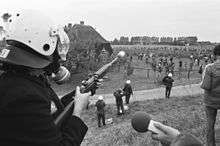
 Netherlands: 84,523 units[67](1940s-1970s, Army and Police)
Netherlands: 84,523 units[67](1940s-1970s, Army and Police) Nicaragua: 121 units[67]
Nicaragua: 121 units[67] Nigeria: 100 units[67]
Nigeria: 100 units[67] Norway: 98,267 units[67](Norwegian Army 1951-1970, with some Norwegian police units until the 1990s)
Norway: 98,267 units[67](Norwegian Army 1951-1970, with some Norwegian police units until the 1990s) Pakistan: 45 units[67]
Pakistan: 45 units[67] Panama: 917 units[67]
Panama: 917 units[67] Peru: 821 units[67]
Peru: 821 units[67] Saudi Arabia: Used by the Saudi Army.
Saudi Arabia: Used by the Saudi Army. South Vietnam: 793,994 units[67] (1960s–70s)
South Vietnam: 793,994 units[67] (1960s–70s) Thailand: 73,012 units[67] Locally known as the ปสบ.87.
Thailand: 73,012 units[67] Locally known as the ปสบ.87. Tunisia: 771 units[67]
Tunisia: 771 units[67] Turkey: 450 units.[67] Used in Korean War.[90]
Turkey: 450 units.[67] Used in Korean War.[90] United Kingdom: 200,766 units[67] (Limited use by the British military from 1943 to the 1960s and by the Royal Ulster Constabulary in Northern Ireland until the 1980s)
United Kingdom: 200,766 units[67] (Limited use by the British military from 1943 to the 1960s and by the Royal Ulster Constabulary in Northern Ireland until the 1980s) United States: 6,110,730 units[67](1940s–60s/70s, Armed Forces and 1940s-present, various law enforcement agencies, and the Tennessee Valley Authority)
United States: 6,110,730 units[67](1940s–60s/70s, Armed Forces and 1940s-present, various law enforcement agencies, and the Tennessee Valley Authority) Uruguay: 32,346 units[67]
Uruguay: 32,346 units[67] USSR: 7 units[67]
USSR: 7 units[67] Vietnam: (Largely captured and/or inherited from now-defunct Army of the Republic of Vietnam)[67][91]
Vietnam: (Largely captured and/or inherited from now-defunct Army of the Republic of Vietnam)[67][91]
Variants
The standard-issue versions of the carbine officially listed and supported were the M1, M1A1, M2 and M3.[92]

Carbine, Cal .30, M1A1
- Side-folding stock, 15-round magazine
- Paratrooper model
- About 150,000 produced
Carbines originally issued with the M1A1 folding stock were made by Inland, a division of General Motors and originally came with the early "L" nonadjustable sight and barrel band without bayonet lug. Inland production of M1A1 carbines was interspersed with Inland production of M1 carbines with the standard stock. Stocks were often swapped out as carbines were refurbished at arsenals. An original Inland carbine with an original M1A1 stock is rare today.
Carbine, Cal .30, M1A2
- Proposed variant with improved sight adjustable for windage and elevation
- Produced only as 'overstamped' model (an arsenal-refurbished M1 with new rear sight and other late M1 improvements)
Carbine, Cal .30, M1A3
- Underside-folding pantograph stock, 15-round magazine.
- Type standardized to replace the M1A1 but may not have been issued.
- Pantograph stock was more rigid than the M1A1's folding stock and folded flush under the fore end. A more common name for this type of stock is an underfolder.
Carbine, Cal .30, M2


- Early 1945
- Selective fire (capable of fully automatic fire)
- 30-round magazine or 15 standard issue
- About 600,000 produced
Initially, the M1 carbine was intended to have a selective-fire capability, but the decision was made to put the M1 into production without this feature. Fully automatic capability was incorporated into the design of the M2 (an improved, selective-fire version of the M1), introduced in 1944. The M2 featured the late M1 improvements to the rear sight, addition of a bayonet lug, and other minor changes.
Research into a conversion kit for selective fire began May 1944; the first kit was developed by Inland engineers, and known as the T4. Inland was awarded a contract for 500 T4 carbines in September 1944. Although the conversion was seen as satisfactory, the heavier 30-round magazine put greater strain on the magazine catch, necessitating the development of a sturdier catch. The slide, sear, and stock design also had to be modified. On fully automatic fire, the T4 model could fire about 750 rounds per minute, but generated a manageable recoil.[93]
Although some carbines were marked at the factory as M2, the only significant difference between an M1 and M2 carbine is in the fire control group. The military issued field conversion kits (T17 and T18) to convert an M1 to an M2. Legally a carbine marked M2 is always a machine gun for national firearms registry purposes.
These M2 parts including the heavier M2 stock were standardized for arsenal rebuild of M1 and M1A1 carbines.
A modified round bolt replaced the original flat top bolt to save machining steps in manufacture. Many sources erroneously refer to this round bolt as an 'M2 bolt' but it was developed as a standard part for new manufacture M1 and later M2 carbines and as a replacement part, with priority given to use on M1A1 and M2 carbines.[94] The slightly heavier round bolt did moderate the cyclic rate of the M2 on full automatic.[95]
Despite being in demand, very few M2 carbines saw use during World War II, and then mostly in the closing days against Japan.[96] The M2 carbine was logistically compatible with the millions of M1 carbines in U.S. service, and offered longer range, better accuracy and better penetration than (pistol caliber) submachine guns like the Thompsons and Grease Guns.[97] Therefore, after World War II, the M2 carbine largely replaced the submachine-guns in U.S. service, until it was itself replaced by the M16 rifle.[46]
The M2 model was the most widely used Carbine variant during the Korean War.[98] A detailed study of the effectiveness of the M2 in the Korean conflict was assembled by S. L. A. Marshall. He found that many troops complained on the lack of effective range of the gun, which allowed the enemy to get close enough to throw hand grenades. A more detailed analysis showed however that most troops who complained actually tended to run low on ammo, because they fired their M2 on fully automatic too soon. Troops who fired their guns on semi-automatic at distance generally complained less about the M2's effectiveness. Generally, the more seasoned troops used the latter approach. The carbine was usually given to second line troops (administrative, support, etc.), who had little combat experience and also did not have much training in small-unit tactics, but who usually had to engage the enemy at some critical moment, like a breakthrough or ambush. Marshall noted that almost all killing shots with carbines in Korea were at ranges of 50 yards or less. It was unsurprising therefore that the M2 was a preferred weapon for night patrols.[99] The M2 was also used in the early stages of the Vietnam War by special forces, ARVN advisers, and air crews.[100]
Contemporary authors have struggled to categorize the M2 carbine. On one hand, it is more powerful than a submachine gun and is considered by some to be an assault rifle, even though it fires a projectile considerably less powerful than the StG 44's 7.92×33mm Kurz. On the other hand, the M2 can also be considered a precursor of the modern personal defense weapon (PDW) concept, even though contemporary guns in that category, like the FN P90, fire substantially different cartridges like the 5.7×28mm.[101]
Carbine, Cal. 30, M2A2
- Arsenal-refurbished (overstamped M2) model
Carbine, Cal .30, M3
- M2 with mounting (T3 mount) for an early active (infrared) night vision sight.
- About 3,000 produced.
- Three versions of night sight (M1, M2, M3)
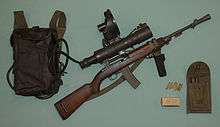
The M3 carbine was an M2 carbine fitted with a mount designed to accept an infrared sight for use at night. It was initially used with the M1 sniperscope, and an active infrared sight, and saw action in 1945 with the Army during the invasion of Okinawa. Before the M3 carbine and M1 sniperscope were type-classified, they were known as the T3 and T120, respectively. The system continued to be developed, and by the time of the Korean War, the M3 carbine was used with the M3 sniperscope.
The M2 sniper scope extended the effective nighttime range of the M3 carbine to 100 yards. In the later stages of the Korean War, an improved version of the M3 carbine, with a revised mount, a forward pistol grip, and a new M3 sniperscope design was used in the latter stages of Korea and briefly in Vietnam. The M3 sniperscope had a large active infrared spotlight mounted on top of the scope body itself, allowing use in the prone position. The revised M3/M3 had an effective range of around 125 yards.[45] Eventually, the M3 carbine and its M3 sniperscope would be superseded by passive-design night vision scopes with extended visible ranges; the improved scopes in turn required the use of rifle-caliber weapons with flatter trajectories and increased hit probability.
Derivatives
Ingram SAM
The Ingram SAM rifles are M1 carbine derivatives in 5.56×45mm NATO (SAM-1), 7.62×39mm (SAM-2) and 7.62×51mm NATO (SAM-3). These are occasionally found on auction sites for collectors. The 5.56×45mm versions accept M16 magazines, the 7.62×39mm accept AK magazines and the 7.62×51mm versions use FN FAL magazines.
Military contractors
- Inland Division, General Motors (production: 2,632,097), sole producer of the M1A1 Carbine. Receiver marked "INLAND DIV."
- Winchester Repeating Arms (production: 828,059) Receiver marked "WINCHESTER"[102]
- Irwin-Pedersen (operated by Saginaw Steering Gear and production included with Saginaw total)
- Saginaw Steering Gear Division, General Motors (production: 517,213 ) Receivers marked "SAGINAW S.G." (370,490) and "IRWIN-PEDERSEN" (146,723 )
- Underwood Elliot Fisher (production: 545,616) Receiver marked "UNDERWOOD"
- National Postal Meter (production: 413,017) Receiver marked "NATIONAL POSTAL METER"
- Quality Hardware Manufacturing Corp. (production: 359,666) Receiver marked "QUALITY H.M.C."
- International Business Machines (production: 346,500) Receiver marked "I.B.M. CORP." Also barrel marked "IBM Corp"
- Standard Products (production: 247,100) Receiver marked "STD. PRO."
- Rock-Ola Manufacturing Corporation (production: 228,500) Receiver Marked "ROCK-OLA"[103]
- Commercial Controls Corporation (production: 239) Receiver marked "COMMERCIAL CONTROLS"
Commercial copies
Several companies manufactured copies of the M1 carbine after World War II, which varied in quality. Some companies used a combination of original USGI and new commercial parts, while others manufactured entire firearms from new parts, which may or may not be of the same quality as the originals. These copies were marketed to the general public and police agencies but were not made for or used by the U.S. military.
In 1963, firearms designer Melvin M. Johnson introduced a version of the M1 carbine called the "Spitfire" that fired a 5.7 mm (.22 in) wildcat cartridge known as the 5.7 mm MMJ or .22 Spitfire.[13] The Spitfire fired a 40-grain (2.6 g) bullet with a muzzle velocity of 2850 ft/s (870 m/s) for a muzzle energy of 720 foot-pounds force (980 J).[104] Johnson advertised the smaller caliber and the modified carbine as a survival rifle for use in jungles or other remote areas.[104] While the concept had some military application when used for this role in the selective-fire M2 carbine, it was not pursued, and few Spitfire carbines were made.[104]

More recently, the Auto-Ordnance division of Kahr Arms began production of an M1 carbine replica in 2005 based on the typical M1 carbine as issued in 1944, without the later adjustable sight or barrel band with bayonet lug. The original Auto-Ordnance had produced various parts for IBM carbine production during World War II, but did not manufacture complete carbines until the introduction of this replica. The AOM110 and AOM120 models (no longer produced) featured birch stocks and handguards, Parkerized receivers, flip-style rear sights and barrel bands without bayonet lugs. The current AOM130 and AOM140 models are identical except for American walnut stocks and handguards.[105][106]
In 2014, Inland Manufacturing, LLC in Dayton, Ohio introduced the reproduction of the "Inland M1 Carbine". Inland Manufacturing, LLC is a private entity that is producing reproductions of the M1 Carbine and M1A1 Paratrooper models that were built by the original Inland Division of General Motors from 1941 to 1945. The new Inland M1 carbines feature many of the same characteristics of the original Inland Carbines and are manufactured in the USA. The M1 carbine is modeled after the last production model that Inland manufactured in 1945 and features a type 3 bayonet lug / barrel band, adjustable rear sights, push button safety, round bolt, and “low wood” walnut stock, and a 15-round magazine. A 30-round mag catch was utilized to allow high-capacity magazines. A “1944” M1 Carbine is also available that has the same features as the 1945 only with a Type 2 barrel Band and 10-round magazine and is available for sale in most states with magazine capacity & bayonet lug restrictions. The M1A1 is modeled after a late production 1944 M1A1 Paratrooper model with a folding “low wood” walnut stock, Type two barrel band, and includes the same adjustable sights which were actually introduced in 1944.[107]
An Israeli arms company (Advanced Combat Systems) offers a modernized bullpup variant called the Hezi SM-1.[108] The company claims accuracy of 1.5 MOA at 100 yards (91 m).[109]
Other commercial manufacturers have included:
- Alpine of Azusa, Calif.[110]
- AMAC or Jacksonville, Ark. (acquired Iver Johnson Arms)[111]
- AMPCO of Miami, Fla.[112]
- Bullseye Gun Works of Miami, Fla.[113]
- Crosman Air Rifle; produced an M1 Carbine lookalike[114]
- ERMA's Firearms Manufacturing of Steelville, Mo.[115]
- Erma Werke of Dachau, Bavaria serviced carbines used by the West German police post World War II. Manufactured replacement parts for the same carbines. Manufactured .22 replica carbines for use as training rifles for police in West Germany and Austria and for commercial export worldwide.[116][117]
- Federal Ordnance of South El Monte, Calif.[118]
- Fulton Armory of Savage, MD[119]
- Global Arms[120]
- H&S of Plainfield, NJ (Haas & Storck, predecessor of Plainfield Machine)[121]
- Howa of Nagoya, Japan, made carbines and parts for the post-World War II Japanese and Thai militaries, and limited numbers of a hunting rifle version[122]
- Inland Manufacturing of Dayton, Ohio[123]
- Israel Arms International (IAI) of Houston, Texas assembled carbines from parts from other sources[124]
- The Iver Johnson Arms of Plainfield, NJ and later Jacksonville, Ark., (acquired M1 Carbine operations of Plainfield Machine) and followed the lead of Universal in producing a pistol version called the "Enforcer".[125]
- Johnston-Tucker of St. Louis, Mo.[126]
- Millvile Ordnance (MOCO) of Union, N.J. (predecessor of H&S)[127]
- National Ordnance of Azusa, Calif. and later South El Monte, Calif.[128]
- NATO of Atlanta, GA[129]
- Plainfield Machine Company of Plainfield, N.J. and later Middlesex, N.J. (P.O. Box in Dunellen, N.J.), M1 Carbine manufacture later purchased and operated by Iver Johnson[130]
- Rock Island Armory of Geneseo, Ill.[131]
- Rowen, Becker Company of Waterville, Ohio[132]
- Springfield Armory of Geneseo, Ill.[133]
- Texas Armament Co. of Brownwood, Tex.[134]
- Tiroler Sportwaffenfabrik und Apparatenbau GmbH of Kugstein, Austria manufactured an air rifle that looked and operated like the M1 Carbine for use in training by Austria and West Germany.[135]
- Universal Firearms of Hialeah, Fla. - Early Universal guns were, like other manufacturers, assembled from USGI parts. However, beginning in 1968, the company began producing the "New Carbine", which externally resembled the M1 but was in fact a completely new firearm internally, using a different receiver, bolt carrier, bolt, recoil spring assembly, etc. with almost no interchangeability with GI-issue carbines.[136] Universal was acquired by Iver Johnson in 1983 and moved to Jacksonville, Ark. in 1985.
- Williams Gun Sight of Davison, Mich. produced a series of 50 sporterized M1 Carbines[137]
Hunting and civilian use
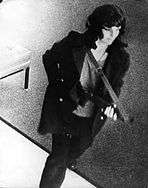
After World War II, the M1 carbine became a popular plinking and ranch rifle. It is still popular with civilian shooters around the world and is prized as a historically significant collector's item. The Carbine continues to be used in military marksmanship training and competitive target matches conducted by rifle clubs affiliated with the Civilian Marksmanship Program (CMP.)
The M1 carbine can be used for big-game hunting, such as white-tailed deer and mule deer at close range (less than 100 yards), but is definitely underpowered for larger North American game such as red deer, elk, moose, and bear. A standard .30 Carbine soft-point round weighs 110 grains (7.1 g) and has a muzzle velocity of about 1,990 ft/s (610 m/s) giving it about 967 ft·lbf (1,311 joules) of energy.[138] By comparison, a 110gr .357 Magnum bullet fired from an 18" rifle barrel, has a muzzle velocity of 1718 ft/s (523 m/s) and 720 ft/lb (976 joules) of muzzle energy.[139] 30 Carbine sporting ammunition is factory recommended for hunting and control of large varmints like coyote, fox or bobcat.[138]
Some U.S. states prohibit use of the .30 Carbine cartridge for hunting deer and larger animals due to a lessened chance of killing an animal in a single shot, even with expanding bullets. The M1 Carbine is also prohibited for hunting in several states such as Pennsylvania[140] because of the semi-automatic function, and Illinois[141] which prohibits all non-muzzleloading rifles for big game hunting. Five-round magazines are commercially made for use in states that limit the capacity of semi-automatic hunting rifles.
Some indoor pistol ranges may permit the firing of an M1 carbine, as its bullet is comparable to magnum handgun rounds, whereas an AR-15, AK-47 or other high-velocity rifle might penetrate the backstop.
New Jersey lists the "M1 Carbine Type" as a banned assault firearm although most examples of the M1 Carbine technically meet the restrictions on semi-automatic rifles identified by the state. Although not banned by name, make or model, M1 Carbines may in some cases be classified as contraband assault weapon under the 2013 NY SAFE act if they feature bayonet lugs, pistol grips, folding stocks and flash suppressors. 10-round magazines are available in states that restrict magazine capacity for civilian firearms.
The M1 carbine was also used by various law enforcement agencies and prison guards, and was prominently carried by riot police during the civil unrest of the late 1960s and early 1970s; until it was replaced in those roles by more modern .223 caliber semi-automatic rifles such as the Ruger Mini-14 and the Colt AR-15 type rifles in the late 1970s and early 1980s.
The ease of use and great adaptability of the weapon led to it being used by Malcolm X and Patty Hearst. Both were featured in famous news photographs carrying the carbine.
Related equipment and accessories
Ammunition types
The ammunition used by the military with the carbine include:[142]
- Cartridge, Caliber .30, Carbine, Ball, M1
- Cartridge, Grenade, Caliber .30, M6 (also authorized for other blank firing uses, due to a lack of a dedicated blank cartridge)
- Cartridge, Caliber .30, Carbine, Dummy, M13
- Cartridge, Caliber .30, Carbine, Ball, Test, High Pressure, M18
- Cartridge, Caliber .30, Carbine, Tracer, M16 (also rated as having an incendiary effect)
- Cartridge, Caliber .30, Carbine, Tracer, M27 (dimmer illumination and no incendiary effect)
See also
Notes
- ↑ The M1 Carbine by Leroy Thompson
- ↑ Meche, W. Derek, M1 Carbine: The collector’s item you can actually use, Guns.com, 6 June 2013, http://www.guns.com/review/2013/06/06/m1-carbine/
- 1 2 3 Military Small Arms of the 20th Century. 7th Edition. Ian V. Hogg & John S. Weeks. Krause Publications. 2000. page 290
- ↑ International Encyclopedia of Military History. James C. Bradford. Routledge, Dec 1, 2004. page 886
- 1 2 3 4 5 George, John, Shots Fired In Anger, (2nd ed., enlarged), Washington, D.C.: NRA Press, ISBN 0-935998-42-X, 9780935998429 (1981), p. 394
- ↑ Weeks, John, World War II Small Arms, London: Orbis Publishing Ltd. and New York: Galahad Books, ISBN 0-88365-403-2, ISBN 978-0-88365-403-3 (1979), p. 130
- ↑ https://www.youtube.com/watch?v=2ozvYaxr6iQ
- ↑ Larry Ruth, M1 Carbine: Design, Development & Production, (The Gun Room Press, 1979, ISBN 0-88227-020-6) contains many Ordnance documents related to the "Light Rifle" specification that led to the M1 carbine
- ↑ Larry Ruth, M1 Carbine: Design, Development & Production, Gun Room Press, 1979.
- 1 2 3 Canfield, Bruce N., "'Carbine' Williams: Myth & Reality", The American Rifleman, February 2009.
- ↑ Bishop, Chris (1998). The Encyclopedia of Weapons of World War II. New York: Orbis Publiishing Ltd. ISBN 0-7607-1022-8..
- ↑ E.H. Harrison, "Who Designed the M1 Carbine?", in U.S. Caliber .30 Carbine, NRA American Rifleman Reprint.
- 1 2 3 Barnes, Frank C., Cartridges of the World, Iola WI: DBI Books Inc., ISBN 0-87349-033-9, ISBN 978-0-87349-033-7 (6th ed., 1989), p. 52
- ↑ Jane's Gun Recognition Guide. Ian Hogg & Terry Gander. HarperCollins Publishers. 2005. page 330
- 1 2 Green Beret in Vietnam: 1957-73. Gordon Rottman. Osprey Publishing, 2002. p. 41
- ↑ Roberts, Joe American Rifleman (December 2007) p.20
- ↑ Dunlap, Roy, Ordnance Went Up Front, Samworth Press (1948), p. 293
- 1 2 Shore, C. (Capt), With British Snipers To The Reich, Lancer Militaria Press (1988), pp. 191-195
- ↑ http://www.ibiblio.org/hyperwar/USA/ref/FM/PDFs/FM23-7.PDF FM 23-7. WAR DEPARTMENT BASIC FIELD MANUAL. U. S. CARBINE, CALIBER .30, Ml. May 20, 1942
- 1 2 3 The M1 Carbine, Leroy Thompson, Bloomsbury Publishing, Nov 20, 2011. page 26, 27
- 1 2 3 4 5 "RJ Militaria - The M1 carbine - short history". Retrieved 29 October 2015.
- ↑ US Marine Corps 1941-45, By Gordon Rottman Osprey Publishing. Copyright 1995, page 14.
- ↑ Green Beret in Vietnam: 1957-73, By Gordon Rottman Osprey Publishing. Copyright 2002, page 41.
- ↑ "Carbine magazine catches". CMP. Retrieved 10 February 2016.
- ↑ http://www.gunsandammo.com/blogs/history-books/m1-carbine-americas-unlikely-warrior/ Guns & Ammo. M1 Carbine: America’s Unlikely Warrior. by Garry James. October 6th, 2014
- ↑ "RJ Militaria - Collecting The M1 carbine". Retrieved 29 October 2015.
- ↑ Cartridges and Firearm Identification. By Robert E. Walker, CRC Press, page 254
- 1 2 Ruth, Larry L. War Baby: The U.S. Caliber .30 Carbine, Vol. 1, Collector Grade Publications, ISBN 0-88935-117-1, ISBN 978-0-88935-117-2 (1992), pp. 621-623
- 1 2 Dunlap, Roy, Ordnance Went Up Front, Plantersville, SC: Small-Arms Technical Pub. Co., The Samworth Press, ISBN 1-884849-09-1 (1948), p. 240
- ↑ "From the Civilian Marksmanship Program Auction" - CMP
- ↑ "A Pocket History of the M1 Carbine" - Fulton Armory
- ↑ Rush, Robert S., GI: The US Infantryman in World War II, Osprey Publishing Ltd. (2003), ISBN 1-84176-739-5, p. 33: Officers were issued .45 M1911 pistols as individual weapons until 1943, when they were issued the M1 Carbine in place of the pistol.
- ↑ Rush, Robert S., GI: The US Infantryman in World War II, Osprey Publishing Ltd. (2003), ISBN 1-84176-739-5, pp. 33-35: Officers and NCOs, as well as airborne and other elite troops were frequently allowed to exchange with Ordnance personnel for their individual weapon of choice.
- ↑ Shore, C. (Capt), With British Snipers To The Reich, Mount Ida AR: Lancer Militaria Press, ISBN 0-935856-02-1, ISBN 978-0-935856-02-6 (1988), pp. 191-195: Small-statured men such as Capt. Shore and Sgt. Audie Murphy liked the carbine, as its small stock dimensions fit them particularly well.
- ↑ McManus, John C., The Deadly Brotherhood: The American Combat Soldier in World War II, New York: Random House Publishing, ISBN 0-89141-823-7 (1998), p. 52: Sergeant Herbert Miller of the U.S. 6th Armored Division stated that he "was very happy with the carbine...It's fast, it's easy to use in a hurry. For churches and houses and things like that, it was good."
- ↑ Gavin, James M. (Lt. Gen.), War and Peace in the Space Age, New York: Harper and Brothers (1958), pp. 57, 63: Col. Gavin's love affair with his M1A1 carbine ended in Sicily, when his carbine and that of Maj. Vandervoort jammed repeatedly. Noticing that carbine fire rarely suppressed rifle fire from German infantry, he and Vandervoort traded with wounded soldiers for their M1 rifles and ammunition; Gavin carried an M1 rifle for the rest of the war.
- ↑ Burgett, Donald, Seven Roads To Hell, New York: Dell Publishing (1999), ISBN 0-440-23627-4 pp. 153-154: Burgett, a machine-gunner in the 101st Airborne from Normandy to the Battle of the Bulge, witnessed several failures of the .30 carbine to stop German soldiers after being hit.
- ↑ Chapman, F. Spencer, The Jungle Is Neutral: A Soldier's Two-Year Escape from the Japanese Army, Lyons Press, 1st ed., ISBN 1-59228-107-9, ISBN 978-1-59228-107-7 (2003), p. 300
- ↑ U.S. Army, Handbook on Japanese Military Forces: Body armor, Technical Manual, 15 September 1944, Chap. X, sec. 4(b) http://www.ibiblio.org/hyperwar/Japan/IJA/HB/HB-10.html
- ↑ George, John, Shots Fired In Anger NRA Press (1981), p. 450
- 1 2 3 Dunlap, Roy, Ordnance Went Up Front, Samworth Press (1948), p. 297
- ↑ McManus, John C., The Deadly Brotherhood: The American Combat Soldier in World War II, New York: Random House Publishing, ISBN 0-89141-823-7 (1998), p. 52: Private Richard Lovett of the U.S. Americal Division noted that "It didn't have stopping power. Enemy soldiers were shot many times but kept on coming."
- ↑ McManus, John C., The Deadly Brotherhood, p. 52
- 1 2 3 4 Rush, Robert S., US Infantryman in World War II, Osprey Publishing (2002), ISBN 1-84176-330-6, ISBN 978-1-84176-330-9, p.53
- 1 2 3 M3 Infra Red Night Sight Article
- 1 2 The M16. by Gordon Rottman. Osprey Publishing 2011. page 6
- ↑ Leroy Thompson (2011). The M1 Carbine. Osprey Publishing. p. 35. ISBN 978-1-84908-907-4.
- ↑ Canfield, Bruce, Arms of the Chosin Few American Rifleman, 2 November 2010, retrieved 10 May 2011
- ↑ Dill, James, Winter of the Yalu, Changjin Journal 06.22.00
- 1 2 Canfield, Bruce, Arms of the Chosin Few American Rifleman, 2 November 2010, retrieved 10 May 2011
- ↑ Hammel, Eric, Chosin: Heroic Ordeal of the Korean War, Zenith Press, 1st ed., ISBN 978-0-7603-3154-5, ISBN 978-0-7603-3154-5 (2007), p. 205
- 1 2 S.L.A. Marshall, Commentary on Infantry and Weapons in Korea 1950-51, 1st Report ORO-R-13 of 27 October 1951, Project Doughboy [Restricted], Operations Research Office (ORO), U.S. Army (1951)
- ↑ Clavin, Tom, Last Stand of Fox Company, New York: Atlantic Monthly Press, ISBN 0-87113-993-6, ISBN 978-0-87113-993-1 (2009), p. 161
- ↑ O'Donnell, Patrick, Give Me Tomorrow: The Korean War's Greatest Untold Story: The Epic Stand of the Marines of George Company, Da Capo Press 1st ed., ISBN 0-306-81801-9, ISBN 978-0-306-81801-1 (2010), p. 88, 168, 173
- ↑ Clavin, Tom, Last Stand of Fox Company, New York: Atlantic Monthly Press, ISBN 0-87113-993-6, ISBN 978-0-87113-993-1 (2009), p. 113: In addition to their bulky cotton-padded telegroika coats, which could freeze solid with perspiration, Chicom infantry frequently wore vests or undercoats of thick goatskin.
- ↑ Jowett, Philip S., The Chinese Army 1937-49: World War II and Civil War, Osprey Publishing, ISBN 978-1-84176-904-2 (2005), p. 47
- ↑ Thomas, Nigel, The Korean War 1950-53, Osprey Publishing Ltd., ISBN 0-85045-685-1, ISBN 978-0-85045-685-1 (1986), p. 47
- ↑ Andrew, Martin (Dr.), Logistics in the PLA, Army Sustainment, Vol. 42, Issue 2, March–April 2010
- ↑ Thomas, Nigel, The Korean War 1950-53, Osprey Publishing Ltd., ISBN 0-85045-685-1, ISBN 978-0-85045-685-1 (1986), pp. 37, 47: Many Chinese troops carried either rice or shaoping, an unleavened bread flour mixture in a fabric tube slung over the shoulder.
- ↑ Chinese troops frequently wore bandolier-type ammunition pouches and carried extra PPSh or Thompson magazines in addition to 4-5 stick grenades.
- ↑ Russ, Martin, Breakout: The Chosin Reservoir Campaign: Korea 1950, Penguin Publishing, ISBN 0-14-029259-4, ISBN 978-0-14-029259-6 (2000), p. 40: The failure of the .30 carbine round to stop enemy soldiers may not have been due to inadequate penetration. Marine Lt. James Stemple reported that he shot an enemy soldier with his M2 carbine four times in the chest and saw the padding fly out the back of the soldier's padded jacket as the bullets penetrated his body, yet the enemy soldier kept on coming.
- ↑ Clavin, Tom, Last Stand of Fox Company, New York: Atlantic Monthly Press, ISBN 0-87113-993-6, ISBN 978-0-87113-993-1 (2009), pp. 82, 113
- ↑ O'Donnell, Patrick, Give Me Tomorrow: The Korean War's Greatest Untold Story, p. 88
- ↑ Spurr, Russell, Enter the Dragon: China's Undeclared War Against the U.S. in Korea, 1950-51, New York, NY: Newmarket Press, ISBN 978-1-55704-914-8 (1998), p.182: Chinese frontline PLA troops disliked the M1/M2 carbine, as they believed its cartridge had inadequate stopping power. Captured U.S. carbines were instead issued to runners and mortar crews.
- 1 2 3 S.L.A. Marshall, Commentary on Infantry and Weapons in Korea 1950–51, 1st Report ORO-R-13 of 27 October 1951, Project Doughboy [Restricted], Operations Research Office (ORO), U.S. Army (1951)
- 1 2 3 Leroy Thompson (2011). The M1 Carbine. Osprey Publishing. p. 57. ISBN 978-1-84908-907-4.
- 1 2 3 4 5 6 7 8 9 10 11 12 13 14 15 16 17 18 19 20 21 22 23 24 25 26 27 28 29 30 31 32 33 34 35 36 37 38 39 40 41 42 43 44 45 46 47 48 49 50 51 52 53 54 55 http://www.bavarianm1carbines.com/carbinesnara.html
- ↑ Diagram Group (1991). Weapons: An international encyclopedia from 5000 B.C. to 2000 A.D. New York: St. Martin's Press, Inc. ISBN 0-312-03950-6.
- ↑ "The Jungle Beat - Roy Follows, of Fort Brooke and Cameron Highlands". Retrieved 29 October 2015.
- ↑ William, Jack and Moran, Grace Spearhead in Malaya 1959 P. Davies, p. 239
- ↑ Crawford, Oliver, The Door Marked Malaya, London: Rupert Hart-Davis (1958), p. 88
- ↑ Central Office of Information British Information Services Survey of Current Affairs 1977 H.M Stationery Office
- ↑ Donald M. Goldstein, Katherine V. Dillon and J. Michael Wenger, Nuts! The Battle of the Bulge, Brassey's, 1994, ISBN 0-02-881069-4. Page 75, photo 4-69, captured German film shows German officer armed with a M1 carbine in the Battle of the Bulge, Dec 1944.
- ↑ Foreign Military Assistance
- 1 2 Unwin, Charles C.; Vanessa U., Mike R., eds. (2002). 20th Century Military Uniforms (2nd ed.). Kent: Grange Books. ISBN 1-84013-476-3.
- ↑ Foreign Military Assistance
- ↑ Walter, John (2006). Rifles of the World (3rd ed.). Iola, WI: Krause Publications. p. 147. ISBN 0-89689-241-7.
- ↑ "The Death of Che Guevara: Declassified". The National Security Archive. Retrieved 2016-01-24.
- ↑ "Armas da vida real | Superinteressante". Superinteressante. 2015-05-19. Retrieved 2016-05-05.
- ↑ "David Thompkins Interview". GWU. 14 February 1999. Retrieved 17 October 2011.
- ↑ "Austria's Story". Retrieved 29 October 2015.
- ↑ "U.S. M1 Carbines in Germany". Retrieved 29 October 2015.
- ↑ "Small Arms Survey - Working Papers" (PDF). 4 March 2015. Retrieved 29 October 2015.
- ↑ Rene Jalbert , Canadian hero. YouTube. 21 September 2010. Retrieved 29 October 2015.
- ↑ Hogg, Ian (1989). Jane's Infantry Weapons 1989-90, 15th Edition. Jane's Information Group. p. 216. ISBN 0-7106-0889-6.
- ↑ Gander, Terry J.; Hogg, Ian V. Jane's Infantry Weapons 1995/1996. Jane's Information Group; 21 edition (May 1995). ISBN 978-0-7106-1241-0.
- ↑ "Families Acting for Innocent Relatives (FAIR)". Retrieved 29 October 2015.
- ↑ Jones, Richard (2009). Jane's Infantry Weapons 2009-2010. Jane's Information Group. p. 898. ISBN 0-7106-2869-2.
- ↑ Skennerton (2007)
- ↑ http://www.muratdegirmenci.com/wp-content/uploads/T%C3%BCrk-askeri-korede-resimler.jpg
- ↑ Plaster, John L.; Penguin Group. SOG: The Secret Wars of America's Commandos in Vietnam. Onyx Books; 1 edition (May 1997). ISBN 0-451-19508-6.
- ↑ Department of the Army Technical Manual TM9-1276 and Department of the Air Force Technical Order TO39A-5AD-2, Cal. .30 Carbines, M1, M1A1, M2, and M3. February 1953.
- ↑ Leroy Thompson (2011). The M1 Carbine. Osprey Publishing. pp. 29–30. ISBN 978-1-84908-907-4.
- ↑ Larry Ruth, M1 Carbine: Design, Development & Production, Gun Room Press, 1979, p.173.
- ↑ W.H.B. Smith, Small Arms of the World, Stackpole, 1966, illustrates an M2 carbine in an M1A1 stock on p.642 and a parts breakdown of the M2 on p.646 is shown with a flat top bolt.
- ↑ Leroy Thompson (2011). The M1 Carbine. Osprey Publishing. pp. 53–55. ISBN 978-1-84908-907-4.
- ↑ America's Favorite Gun. by Gold V. Sanders. Popular Science Aug 1944. page 84-87 & 221
- ↑ Leroy Thompson (2011). The M1 Carbine. Osprey Publishing. p. 35. ISBN 978-1-84908-907-4.
- ↑ Leroy Thompson (2011). The M1 Carbine. Osprey Publishing. pp. 57–60. ISBN 978-1-84908-907-4.
- ↑ Leroy Thompson (2011). The M1 Carbine. Osprey Publishing. p. 62. ISBN 978-1-84908-907-4.
- ↑ Leroy Thompson (2011). The M1 Carbine. Osprey Publishing. pp. 68–70. ISBN 978-1-84908-907-4.
- ↑ Canfield, June 2007, p. 37
- ↑ "Rock-Ola M1 Carbine". Retrieved 29 October 2015.
- 1 2 3 Barnes, Frank C., Cartridges of the World, Iola WI: DBI Books Inc., ISBN 0-87349-033-9, ISBN 978-0-87349-033-7 (6th ed., 1989), p. 127.
- ↑ "Auto-Ordnance M1 Carbines" - Auto-Ordnance.com
- ↑ ""M1 Carbine" - American Rifleman". Retrieved 29 October 2015.
- ↑ Robert A. Sadowski. "Inland Manufacturing Releases 'American Classic' M1 Carbines". Tactical Life Gun Magazine: Gun News and Gun Reviews. Retrieved 29 October 2015.
- ↑ "ACS (ADVANCED COMBAT SYSTEMS Ltd.) Hezi SM-1". Retrieved 29 October 2015.
- ↑ "advancedcombat.com". Retrieved 29 October 2015.
- ↑ "Alpine". Retrieved 29 October 2015.
- ↑ "AMAC M1 Carbine". Retrieved 29 October 2015.
- ↑ "M1CarbinesInc.com". Retrieved 29 October 2015.
- ↑ "Bullseye Gun Works". Retrieved 29 October 2015.
- ↑ "M1CarbinesInc.com". Retrieved 29 October 2015.
- ↑ "Erma's Manufacturing". Retrieved 29 October 2015.
- ↑ "U.S. Carbines during the American Occupation". Retrieved 29 October 2015.
- ↑ "Erma Werke". Retrieved 29 October 2015.
- ↑ "Federal Ordnance". Retrieved 29 October 2015.
- ↑ "Fulton Armory". Fulton Armory. Retrieved 29 October 2015.
- ↑ "Global Arms". Retrieved 29 October 2015.
- ↑ "H&S M1 Carbine". Retrieved 29 October 2015.
- ↑ "HOWA M1 Carbine". Retrieved 29 October 2015.
- ↑ "About Inland Manufacturing". Retrieved 29 October 2015.
- ↑ "Israel Arms International". Retrieved 29 October 2015.
- ↑ "Iver Johnson Arms". Retrieved 29 October 2015.
- ↑ "Johnston-Tucker M1 Carbine"
- ↑ "Millville Ordnance Company". Retrieved 29 October 2015.
- ↑ "National Ordnance M1 Carbine". Retrieved 29 October 2015.
- ↑ "NATO M1 Carbine". Retrieved 29 October 2015.
- ↑ "Plainfield Machine Co.". Retrieved 29 October 2015.
- ↑ "Rock Island Armory M1 Carbine"
- ↑ "Rowen Becker M1 Carbine"
- ↑ "Springfield Armory, Inc.". Retrieved 29 October 2015.
- ↑ "Texas Armaments M1 Carbine"
- ↑ "M1CarbinesInc.com". Retrieved 29 October 2015.
- ↑ "Universal Firearms Corp.". Retrieved 29 October 2015.
- ↑ "Williams Gun Sight M1 Carbines". Retrieved 29 October 2015.
- 1 2 http://www.winchester.com/Products/rifle-ammunition/super-x/hollow-soft-point/Pages/X30M1.aspx
- ↑ http://www.ballisticsbytheinch.com/357mag.html
- ↑ Pennsylvania Game Commission - State Wildlife Management Agency: Deer Hunting Laws and Regulations
- ↑ Illinois: Digest of Hunting and Trapping Regulations 2007-2008, "Statewide Deer Hunting Information", Illinois Department of Natural Resources, p. 11.
- ↑ TM 9-1305-200/TO 11A13-1-101 Small-Arms Ammunition, 1961, p. 39-41
Further reading
- Barnes, Frank C., Cartridges of the World, Iola, WI: DBI Books Inc., ISBN 0-87349-033-9, ISBN 978-0-87349-033-7, (6th ed., 1989).
- Canfield, Bruce N. (June 2007). "A New Lease on Life: The Post-World War II M1 Carbine". American Rifleman.
- Dunlap, Roy F. Ordnance Went Up Front, Plantersville, SC: Small-Arms Technical Pub. Co., The Samworth Press, ISBN 1-884849-09-1 (1948).
- George, John (Lt. Col.), Shots Fired In Anger, (2nd ed., enlarged), Washington, D.C.: NRA Press, ISBN 0-935998-42-X, 9780935998429 (1981).
- Hufnagl, Wolfdieter. U.S.Karabiner M1 Waffe und Zubehör, Motorbuchverlag, 1994.
- IBM Archives
- Korean War cold weather malfunctions
- Laemlein, Tom., The M1 Carbine. Stamford, CT: Historical Archive Press, 2006. ISBN 0-974-83892-6 OCLC 82494967
- Marshall, S.L.A., Commentary on Infantry and Weapons in Korea 1950-51, 1st Report ORO-R-13, Project Doughboy, Report ORO-R-13 of 27 October 1951 [Restricted], Operations Research Office (ORO), U.S. Army (1951).
- Shore, C. (Capt), With British Snipers To The Reich, Mount Ida AR: Lancer Militaria Press, ISBN 0-935856-02-1, ISBN 978-0-935856-02-6 (1988).
- United States Government. Departments of the Army and Air Force. TM 9-1305-200/TO 11A13-1-101 Small-Arms Ammunition. Washington, DC: Departments of the Army and Air Force, 1961.
- U.S. Army Catalog of Standard Ordnance Items. Second Edition 1944, Volume III, p. 419
- Weeks, John, World War II Small Arms, London: Orbis Publishing Ltd. and New York: Galahad Books, ISBN 0-88365-403-2, ISBN 978-0-88365-403-3 (1979).
- Worrell, Jessica (2003). "Range of a Rifle Bullet". The Physics Factbook.
External links
| Wikimedia Commons has media related to M1 Carbine. |
- US Army M1 Carbine Technical Manual
- "Lightweight Carbine Increases Firepower." Popular Science, June 1942, pp. 79–80, first detailed general public article published.
- M1 Carbine Article
- M1 Carbine Family: M1, M1A1, M2, M3
- The M1/M2 Carbine Magazine FAQ
- Auto-Ordnance M1 Carbines
- Inland Mfg, LLC M1 Carbines
- 90th Reference manual page including FM 23-7 Carbine, 1942 manual
- Articles page including information on blank adapting the M1 carbine
- M1 Carbine page at Modern Firearms
- M1 Carbine Bayonet (M4 Bayonet-Knife)
- Complete set of M1 Carbine Manuals
